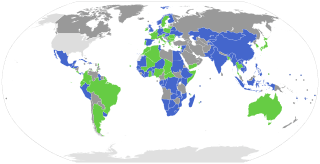Nagoya Protocol
| Nagoya Protocol on Access to Genetic Resources and the Fair and Equitable Sharing of Benefits Arising from their Utilization to the Convention on Biological Diversity | |
|---|---|
|
Parties
signed, but not ratified
non signatory, but Biological Diversity Convention party
non signatory, non-Biological Diversity Convention party
Besides several member states, the EU is also a party (not on map) | |
| Type | Environmental |
| Signed | 29 October 2010 |
| Location | Nagoya, Japan |
| Effective | 12 October 2014 |
| Condition | 50 ratifications |
| Signatories | 92 |
| Parties | 89 |
| Depositary | Secretary-General of the United Nations |
| Languages | Arabic, Chinese, English, French, Russian and Spanish |
The Nagoya Protocol on Access to Genetic Resources and the Fair and Equitable Sharing of Benefits Arising from their Utilization to the Convention on Biological Diversity, also known as the Nagoya Protocol on Access and Benefit Sharing (ABS) is a 2010 supplementary agreement to the 1992 Convention on Biological Diversity (CBD). Its aim is the implementation of one of the three objectives of the CBD: the fair and equitable sharing of benefits arising out of the utilization of genetic resources, thereby contributing to the conservation and sustainable use of biodiversity.[1] However, there are concerns that the added bureaucracy and legislation will, overall, be damaging to the monitoring and collection of biodiversity, to conservation, to the international response to infectious diseases, and to research.[2][3][4]
The Protocol was adopted on 29 October 2010 in Nagoya, Japan, and entered into force on 12 October 2014. It has been ratified by 89 parties, which includes 88 UN member states and the European Union. It is the second Protocol to the CBD; the first is the 2000 Cartagena Protocol on Biosafety.
Scope
The Nagoya Protocol applies to genetic resources that are covered by the CBD, and to the benefits arising from their utilization. The Protocol also covers traditional knowledge associated with genetic resources that are covered by the CBD and the benefits arising from its utilization
Obligations
The Nagoya Protocol sets out obligations for its contracting parties to take measures in relation to access to genetic resources, benefit-sharing and compliance.
Access obligations
Domestic-level access measures aim to:
- Create legal certainty, clarity and transparency
- Provide fair and non-arbitrary rules and procedures
- Establish clear rules and procedures for prior informed consent and mutually agreed terms
- Provide for issuance of a permit or equivalent when access is granted
- Create conditions to promote and encourage research contributing to biodiversity conservation and sustainable use
- Pay due regard to cases of present or imminent emergencies that threaten human, animal or plant health
- Consider the importance of genetic resources for food and agriculture for food security
Benefit-sharing obligations
Domestic-level benefit-sharing measures aim to provide for the fair and equitable sharing of benefits arising from the utilization of genetic resources with the contracting party providing genetic resources. Utilization includes research and development on the genetic or biochemical composition of genetic resources, as well as subsequent applications and commercialization. Sharing is subject to mutually agreed terms. Benefits may be monetary or non-monetary such as royalties and the sharing of research results.
Compliance obligations
Specific obligations to support compliance with the domestic legislation or regulatory requirements of the contracting party providing genetic resources, and contractual obligations reflected in mutually agreed terms, are a significant innovation of the Nagoya Protocol. Contracting Parties are to:
- Take measures providing that genetic resources utilized within their jurisdiction have been accessed in accordance with prior informed consent, and that mutually agreed terms have been established, as required by another contracting party
- Cooperate in cases of alleged violation of another contracting party’s requirements
- Encourage contractual provisions on dispute resolution in mutually agreed terms
- Ensure an opportunity is available to seek recourse under their legal systems when disputes arise from mutually agreed terms
- Take measures regarding access to justice
- Take measures to monitor the utilization of genetic resources after they leave a country including by designating effective checkpoints at any stage of the value-chain: research, development, innovation, pre-commercialization or commercialization
Implementation
The Nagoya Protocol's success will require effective implementation at the domestic level. A range of tools and mechanisms provided by the Nagoya Protocol will assist contracting Parties including:
- Establishing national focal points (NFPs) and competent national authorities (CNAs) to serve as contact points for information, grant access or cooperate on issues of compliance
- An Access and Benefit-sharing Clearing-House to share information, such as domestic regulatory ABS requirements or information on NFPs and CNAs
- Capacity-building to support key aspects of implementation.
Based on a country’s self-assessment of national needs and priorities, capacity-building may help to:
- Develop domestic ABS legislation to implement the Nagoya Protocol
- Negotiate MAT
- Develop in-country research capability and institutions
- Raise awareness
- Transfer technology
- Target financial support for capacity-building and development initiatives through the GEF
Criticism
Many scientists have voiced concern over the protocol, fearing the increased red tape will hamper disease prevention and conservation efforts, and that the threat of possible imprisonment of scientists will have a chilling effect on research.[2][4] Non-commercial biodiversity researchers and institutions such as natural history museums fear maintaining biological reference collections and exchanging material between institutions will become difficult.[3]
See also
Notes
- ↑ "Nagoya Protocol".
- 1 2 "Biopiracy ban stirs red-tape fears".
- 1 2 "The Nagoya Protocol on Access and Benefit Sharing -- International treaty poses challenges for biological collections".
- 1 2 "A plea for open science on Zika". www.sciencemag.org. Retrieved 2016-04-02.
External links
- Signatures and ratifications, un.org
